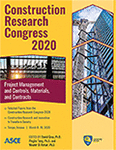Construction Research Congress 2020
Leveraging Automotive Industry Strategies to Define a New Paradigm for Construction-to-Operation Information Handover
Publication: Construction Research Congress 2020: Project Management and Controls, Materials, and Contracts
ABSTRACT
Turnover of information from contractor to the owner of a facility is a critical step in the lifecycle of a project. While various research efforts have defined strategies to turnover design and construction information for owners, these strategies have not substantially improved building operation. This motivated the authors to explore how information is turned over in a different, but related, industry. The authors use owner manuals generated in the automotive industry as a paradigm for refining and organizing construction information and submittals for building owners because these manuals are generally understood by most people. To accomplish this aim, the authors identify common patterns of information structure and the manner in which specific information is provided in car owner manuals. Then they defined analogous building systems and submittal types that would transfer building-related information in a similar manner. For example, they looked at categories of information in the owner’s manual like “Safety & Security”, and suggested CSI specifications that serve a similar purpose in the building realm. They also looked at the format of information provided in those categories and suggested submittal types traditionally used in construction to facilitate information transfer in a similar manner. Once the analogous information and submittal types were identified, the responses were compared for instances of agreement. Complete agreement between individuals was recorded on 17 occasions, and partial agreement on 13. Then, overall consistency in responses was analyzed using Krippendorff’s alpha co-efficient (KALPHA). The KALPHA co-efficient of 0.2 indicates low overall consistency, but considerable agreement in responses for specific systems suggests the potential to organize certain types of construction information according to this alternative paradigm. For sections in which there was little or no agreement, results suggest that car systems may not have analogous building systems. This work demonstrates the potential for structuring building information using an alternative, but commonly used, paradigm from the automotive industry that may be universally understood. Future work will assess the perceptions reported by building owners and usability of this mode of information turnover to assess its viability in actual projects.
Get full access to this article
View all available purchase options and get full access to this chapter.
REFERENCES
Anderson, A., Marsters, A., Dossick, C. S., & Neff, G. (2012). “Construction to operations exchange: challenges of implementing COBie and BIM in a large owner organization.” In Construction Research Congress, 2012 (pp. 688–697). Reston, VA: American Society of Civil Engineers (ASCE).
Aranda-mena, G., Wakefield, R., & Dr. Aranda-Mena, G. (2006). “Interoperability of building information: myth or reality?” In eWork and eBusiness in Architecture, Engineering and Construction.
Becerik-Gerber, B., Jazizadeh, F., Li, N., and Calis, G. (2012). “Application areas and data requirements for BIM-enabled facilities management.” In Journal of Construction Engineering and Management, 138(3), (pp. 431–442).
Boyatzis, R. E. (1998). Transferring qualitative information: Thematic analysis and code development, Sage.
BuildingSMART. (2016). Technical Vision - buildingSMART. Retrieved from https://www.buildingsmart.org/standards/technical-vision.
Capparella, J. (2019). “The 25 best-selling cars, trucks, and SUVs of 2019 (So Far).” Retrieved from https://www.caranddriver.com/news/g27041933/best-selling-cars-2019/.
Cavka, H. B., Staub-French, S., and Pottinger, R. (2015). “Evaluation of organisational context and requirements for leveraging building information models to support handover and operations & maintenance.” In 5thInternational/11thConstruction Specialty Conference, Vancouver, British Columbia 251, (pp. 1–11).
Cavka, H. B., Staub-French, S., & Poirier, E. A. (2017). “Developing owner information requirements for BIM-enabled project delivery and asset management.” In Automation in Construction, 83, (pp. 169–183).
East, W. (2007). Construction Operations Building Information Exchange (COBIE). National Institute of Building Sciences, USA.
Gallaher, M. P., O’Connor, A. C., Dettbarn, J. L. Jr., and Gilday, L. T. (2004). “Cost analysis of inadequate interoperability in the U.S. capital facilities industry.”
Hayes, A. F., & Krippendorff, K. (2007). “Answering the call for a standard reliability measure for coding data.” In Communication Methods and Measures, 1(1), (pp. 77–89).
Howell, Gregory A. (1999). “What is lean construction?” In Seventh Conference of the International Group for Lean Construction, (pp. 1-10).
ISO 16739-1 (2018). “Industry foundation classes (IFC) for data sharing in the construction and facility management industries – Part 1: Data schema.” International Organization for Standardization.
Koskela, L., Ballard, G., Howell, G., & Tommelein, I. (2002). “The foundations of lean construction.” In Design and Construction: Building in Value, (pp. 211–226).
Krippendorff, K. (2011). “Computing Krippendorff's alpha-reliability.” Retrieved from http://repository.upenn.edu/asc_papers/43
Lee, S. K., An, H. K., & Yu, J. H. (2012). “An extension of the technology acceptance model for BIM-based FM”. In Construction Research Congress, (pp. 602–611). American Society of Civil Engineers (ASCE).
Lewis, A., Riley, D., and Elmualim, A. (2010). “Defining high performance buildings for operations and maintenance.” In International Journal of Facility Management, 1, (pp. 1–16).
Mendez, R. O. (2006). "The building information model in facilities management". Masters theses (All Theses, All Years). 708. Retrieved from https://digitalcommons.wpi.edu/etd-theses/708.
Teicholz, P. (2013). BIM for Facility Managers, John Wiley & Sons, Inc (2013).
Wang, X. (2012). “BIM handbook: a guide to building information modeling for owners, managers, designers, engineers and contractors.” In Construction Economics and Building, 12(3), (pp. 101–102).
Information & Authors
Information
Published In
Construction Research Congress 2020: Project Management and Controls, Materials, and Contracts
Pages: 301 - 310
Editors: David Grau, Ph.D., Arizona State University, Pingbo Tang, Ph.D., Arizona State University, and Mounir El Asmar, Ph.D., Arizona State University
ISBN (Online): 978-0-7844-8288-9
Copyright
© 2020 American Society of Civil Engineers.
History
Published online: Nov 9, 2020
Published in print: Nov 9, 2020
Authors
Metrics & Citations
Metrics
Citations
Download citation
If you have the appropriate software installed, you can download article citation data to the citation manager of your choice. Simply select your manager software from the list below and click Download.
